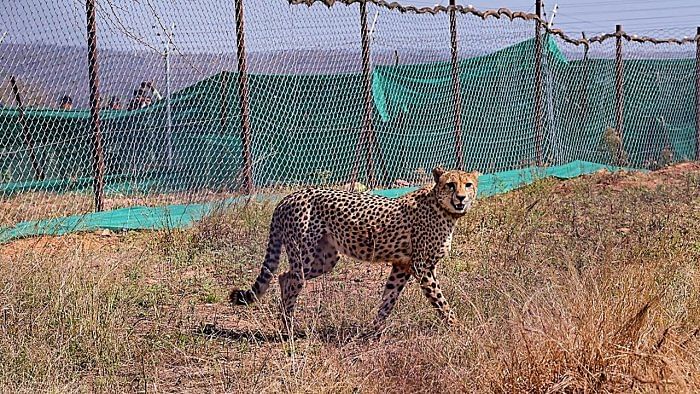
Eleven South African cheetahs have spent the last 11 months of their lives in small holding enclosures in captivity — first in South Africa and then India — making experts jittery about their health and fitness before the animals are released in the wild.
"Since last June, the animals were in 50x50 m enclosures first in South Africa and then at Kuno (Madhya Pradesh). Only last week were they released in the larger 5-hectare enclosure where they can at least roam. Such small enclosures are not sufficient in retaining their physical fitness," Vincent Van Der Merwe, conservationist and Cheetah Metapopulation Project manager told DH.
Merwe and other experts associated with Project Cheetah have shared their concerns with the National Tiger Conservation Authority (NTCA) and Madhya Pradesh forest department officials.
Another round of discussions is likely to happen on Thursday to decide on the release of the South African cheetahs, which arrived on Feb 18.
NTCA officials have ruled out any possibility of poisoning behind the death of the first South African cheetah named Uday, but another expert observed that the animal's death might be caused by botulism, triggered by a toxin.
An official release on Sunday said Kuno National Park officials found cheetah Uday sluggish in his enclosure, and a closer inspection revealed he was staggering.
"What they (veterinarians) found in the initial post-mortem supports a diagnosis of botulism. So it is still the most likely cause of death. The lack of any other identified causes and the symptoms that the cheetah had before he died are strongly suggestive of botulism," said Adrian Tordiffe, associate professor (veterinary pharmacology) at the University of Pretoria, and another advisor to Project Cheetah.
Experts said that the spotted felines were required to be released as quickly as possible as they would need time to establish themselves in a new landscape that didn't have large rocks or tall trees that the animals traditionally use to set up their communication network.
"We have no idea why they (decision-makers) held cheetahs in bomas for so long. This compromises the prospects for successful reintroduction. They are taking an ultra precautionary approach, and are risk-averse. This approach is self-defeating and detrimental to the cheetahs," Merwe said.
The experts’ concerns are in agreement with research findings showing how long periods in captivity can develop stress among cheetahs and may reduce their immune response.
The 12 South African cheetahs came five months after 8 Namibian cheetahs that were released in Kuno last September. One of the Namibian cheetahs died last month due to kidney complications.
The experts and NTCA officials said they had taken into account the possibility of death of up to 40 per cent of the animals (8 out of 20) in the first year of reintroduction.
The world's first trans-continental cheetah reintroduction project was launched last September, more than seven decades after Asian cheetah became extinct in India. The country's last cheetah died in Koriya district of present-day Chhattisgarh in 1947 and the species was declared extinct in 1952.
